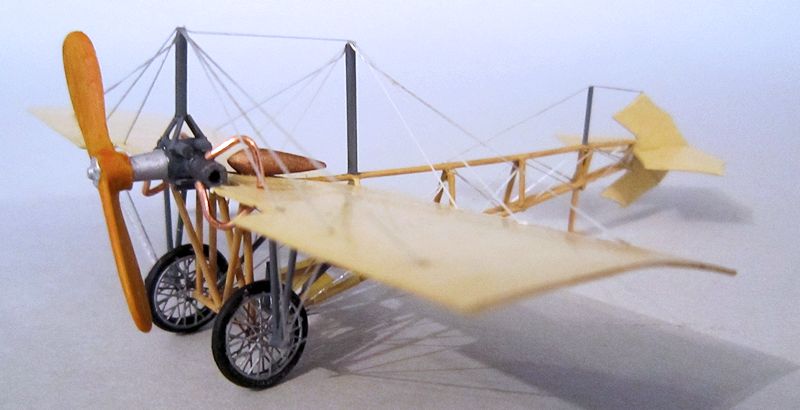
| KIT #: | |
| PRICE: | $ |
| DECALS: | |
| REVIEWER: | Chris Peachment |
| NOTES: | Scratch-built |

| HISTORY |
Alberto
Santos-Dumont is the father of European aviation. He was one of the most famous
men in his day, and is still a much lauded hero in his native Brazil. Born in
1873, into a large very wealthy family of coffee producers. His father used the
most modern technical equipment on his coffee plantation and Alberto was using
the steam tractors and other vehicles from an early age. When his father became
a paraplegic, he sold the plantation for a vast sum, and Alberto settled in
Paris, where he began experimenting with balloons. He designed and built the
first dirigibles, which was the first time a balloon could be steered. And he
won a prize for flying a circuit which involved circling the Eiffel Tower.
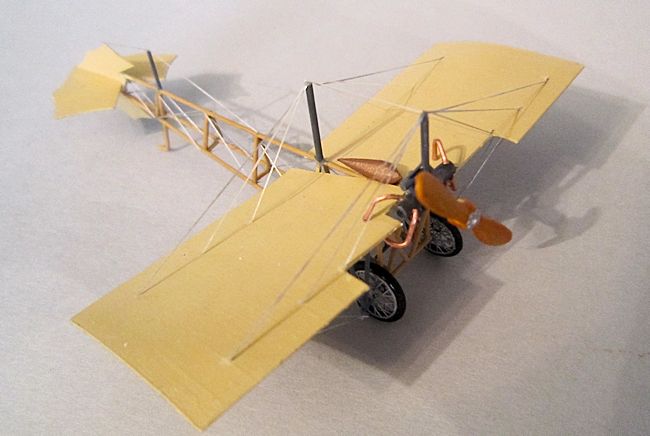 He would often
steer these small craft down the length of fashionable boulevards about 20 feet
above the traffic and crowds, and then tether the craft to a nearby tree while
he took lunch at his favoured restaurant. He would also visit friends by air,
tying the craft to whatever was to hand, sometimes on the roof of the house.
He would often
steer these small craft down the length of fashionable boulevards about 20 feet
above the traffic and crowds, and then tether the craft to a nearby tree while
he took lunch at his favoured restaurant. He would also visit friends by air,
tying the craft to whatever was to hand, sometimes on the roof of the house.
A small, dapper
man, he started a fashion for his high collars, and also for his wide brim
panama hat which he always wore. He even had a special high table and chairs
made, so that he could dine about 12 feet above the ground and get used to being
aloft. One cannot help but wonder if his very small stature, he was no more than
5 feet tall, had something to do with his desire to see the world from above.
Everyone attested that he had perfect manners.
His first heavier
than air machine, the 14bis, took to the air under its own power (as opposed to
the Wright Brothers machine which used launch rails), in October 1906, and was
the first heavier-than-air aircraft flight to be certified by the Aéro Club de
France and the Fédération Aéronautique Internationale (FAI). It was also the
first flight to be witnessed by large crowds, as the Wright Brothers had flown
alone. In France the few who had heard of the Wright Brothers' flight treated it
with some suspicion, if not disbelief. As far as Europe was concerned
Santos-Dumont was king.
The 14bis had a
fairly conventional layout by modern standards, with fuselage, a biplane cell, a
biplane tail and petrol engine with airscrew. The extraordinary thing about it
was that it appeared to fly backwards, at least judged by our own standards of
subsequent aircraft. The pilot sat in a cockpit close to the wings but facing
towards the tail. And the propeller was a pusher rather than tractor.
Santos-Dumont's
next and final designs were the Demoiselle monoplanes (Nos. 19 to 22). These
aircraft were used for his personal transport. The fuselage consisted of three
specially reinforced bamboo booms, and the pilot sat a seat between the main
wheels of a tricycle landing gear. The Demoiselle was controlled by a tail
unit that functioned both as elevator and rudder, and by wing warping.
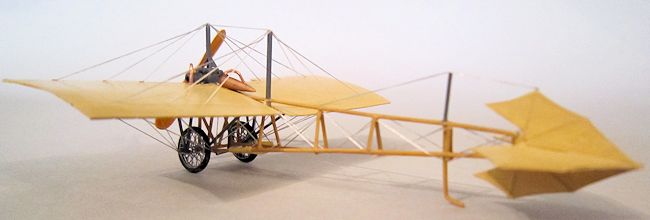 As far as design
goes, he undoubtedly got every element about this light aircraft right, and down
to this day, microlight aircraft adopt the same principles. Albeit with modern
additions such as ailerons. And there are many close replicas here in the
UK, including one at Brooklands Museum, which regularly take to the air.
As far as design
goes, he undoubtedly got every element about this light aircraft right, and down
to this day, microlight aircraft adopt the same principles. Albeit with modern
additions such as ailerons. And there are many close replicas here in the
UK, including one at Brooklands Museum, which regularly take to the air.
It is the only
pre-WWI pioneer aircraft which I would unhesitatingly strap myself into and take
to the air, with perhaps the one modern addition of an air speed indicator. The
balance of aerodynamic forces in the airframe design is perfect and while it
looks flimsy, its well-balanced framework of struts make it strong and light.
Sadly,
Santos-Dumont contracted multiple sclerosis,
which led to increasing depression. He returned to his native Brazil, feted as a
national hero, and retired to a country house which he had designed. It was here
that he died by his own hand in 1932.
His name lives on
as the father of European aviation, but also in the famous Cartier Santos watch,
which Cartier designed especially for him in the form of a wristwatch so that he
did not have to fumble with a pocket watch while timing his flights. The design
continues to this day. As do the innumerable micro-light aircraft which copy the
layout of the Demoiselle.
Demoiselle is French for a damselfly, a delicate flying insect a little like a dragonfly. It also means a young lady, and we get the word damsel from it.
| CONSTRUCTION |
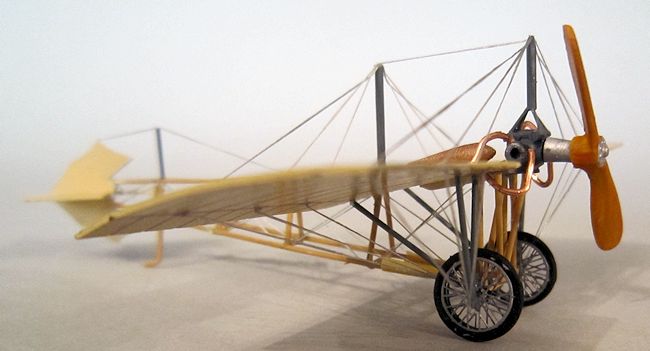 The nice thing
about this little scratch build is that the results look satisfyingly
complicated, and yet the construction is simple and should be possible by anyone
with some experience of scratch building, even if only small parts for injection
kits. The initial impetus came when I discovered an etched spoke wheel set in
1/72 made by Eduard, in varying sizes. This simple discovery opens up a whole
new realm of possibilities in early aircraft.
The nice thing
about this little scratch build is that the results look satisfyingly
complicated, and yet the construction is simple and should be possible by anyone
with some experience of scratch building, even if only small parts for injection
kits. The initial impetus came when I discovered an etched spoke wheel set in
1/72 made by Eduard, in varying sizes. This simple discovery opens up a whole
new realm of possibilities in early aircraft.
The first
difficulty was in discovering from the many plans and photos available (see
below) that no two aircraft looked alike. Some had a king post just ahead of the
tail. Some did not. Some had the petrol tank above the wing, some below.
And the layout for the engine differs from one model to the next. I suggest you
choose the one which you like and which has the most coverage to enable you to
get as accurate as is possible. And bear in mind that many replicas in museums
around the world are not always as accurate as they might be.
I cut out the
wing in one piece first from 20 thou plastic card, and scored the ribs
underneath with a biro and steel rule. Then tape it around a largeish cylinder,
or length of pipe, to get the right camber which is quite marked. This can then
be put aside.
The fuselage is
simply a question of cutting three lengths of rod according to side plan, and
then joining them with short struts to form an inverted pyramid, or fuselage of
triangular cross section with the single spar at the top, and two base spars
below.
 So far so easy.
Now, is the best time to rig the fuselage, which is fiddly but easy enough. The
wires go diagonally from joint to joint, and are made from lengths of elastic
thread, and held with small dots of superglue gel applied with a sharpened
toothpick, A couple of hours under a strong lamp, with some reading lasses in
your nose should see it done. I used two pairs of my normal reading glasses,
perched on the end of my nose. One of those large magnifying glasses on a stand
would be a nifty aid for all this, but I haven't got around to acquiring one
yet. No doubt advancing years will make it imperative sometime soon.
So far so easy.
Now, is the best time to rig the fuselage, which is fiddly but easy enough. The
wires go diagonally from joint to joint, and are made from lengths of elastic
thread, and held with small dots of superglue gel applied with a sharpened
toothpick, A couple of hours under a strong lamp, with some reading lasses in
your nose should see it done. I used two pairs of my normal reading glasses,
perched on the end of my nose. One of those large magnifying glasses on a stand
would be a nifty aid for all this, but I haven't got around to acquiring one
yet. No doubt advancing years will make it imperative sometime soon.
Once done, sit
back with a small reward (I find a glass of single malt is a well deserved
prize) and admire.
The wing now
needs a narrow triangular section cut out from the centre towards the rear, so
that it can sit atop the fuselage but have the trailing edges lower than the top
spar. Check the photos.
The engine was
fashioned from rod of different diameter. It is basically two horizontally
opposed cylinders on each side of a crank case. There are also four struts on
top, forming a pyramid, which will support the forward king post. These are best
added now. The whole was painted matt black with oily steel cylinders and some
gunmetal drybrushing. It can be mounted on the leading edge centre of the wing.
Strangely the
engine was usually water cooled, rather than air cooled, with cooling tubes
mounted within and beneath the wing in the centre sections. Four short copper
pipes carry the coolants to and from the engine and I made these from copper
wire. Fortunately they aren't regular in shape, and were obviously just bent in
situ to fit.
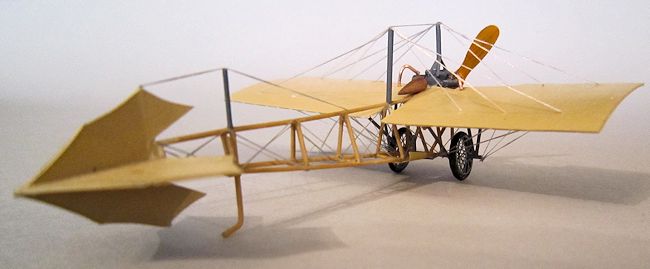 Before turning to
the undercarriage, a seat was made from a length of Tamiya masking tape, and
wound around the lower spars. It seems that Alberto didn't favour a
backrest. It probably kept him from relaxing, something which I doubt any of
those early pilots ever did.
Before turning to
the undercarriage, a seat was made from a length of Tamiya masking tape, and
wound around the lower spars. It seems that Alberto didn't favour a
backrest. It probably kept him from relaxing, something which I doubt any of
those early pilots ever did.
Then the
undercarriage can be addressed. As I said at the beginning it looks complex, but
in fact is not. The inner struts and axle were put in place first. And then the
wheels made up from the etched set. Now comes the trickiest part of the
build. First a couple of old wheels were selected from the Big Bag of Wheels in
the spares box. The centres were taken out, first by drilling and then by a
motor tool, with a grinding wheel on it. And believe me, holding a tiny
piece of ring shaped plastic over a grinding tool with your fingers concentrates
the mind wonderfully. Rather like early aviation. Except that here you will lose
a fingernail and not your life. If you have a pair of rubber o-rings the right
size, then use those.
Then the spoked
wheels must be dished. The Eduard card of instructions suggests using a ball
bearing to push down heavily on the wheel, while supported beneath by the right
shaped dish. Having neither, I improvised by using the wooden handle of an old
chisel, and a wad of some blue tack underneath. The results aren't too bad,
although it helps if you anneal the etch first, by holding over a naked flame
for a while until it colours. This softens the metal somewhat. I still haven't
eradicated the wavy rim effect completely, so I am now wandering around the
streets, my eyes downcast, hoping to come across a ball bearing.
And don't make
the mistake of glueing the rims together first. Add them to the tyre on each
side. You can safely guess how I know this.
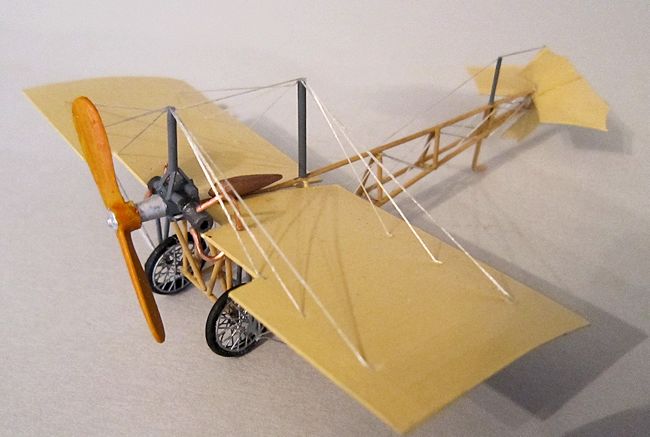 Superglue the
wheels in place, noting they have a distinct toe-out, producing a knock-kneed
effect. Then add tiny outer axles at an angle, from plastic rod, and brace those
with a couple of struts. You will need these little stub axles for rigging,
which can now take place on the underside. Elastic thread, superglue gel,
sharpened toothpick, once again.
Superglue the
wheels in place, noting they have a distinct toe-out, producing a knock-kneed
effect. Then add tiny outer axles at an angle, from plastic rod, and brace those
with a couple of struts. You will need these little stub axles for rigging,
which can now take place on the underside. Elastic thread, superglue gel,
sharpened toothpick, once again.
Once all dry, let
it sit on its wheels and tailskid (bent rod), and cement the three upper
kingposts in place. One on top of the pyramid on top of the engine. Then rig
those. Same deal as above.
Make a fuel tank from sprue sanded into two conical sections. Paint it copper. Make a conical forward propeller support from sanded sprue. Get a prop from the big Bag of Props in your spares box, sand to shape, paint brown with clear orange topcoat, cement in place.
| CONCLUSIONS |
 And there you
have it, one exquisite little Damselfly. It is so light but so sturdy, that when
I knocked off the shelf, it fluttered to earth like a sycamore leaf and didn't
break. It was the first really viable aircraft, all made on the first aircraft
production line, and so good that anyone could fly it. In fact Santos-Dumont was
so kind-hearted he would sell the plans for very little money, and suggest that
it would only take about 15 days to make the plane for anyone with basic
mechanical skills. It wasn't even patented, so keen was he to promote world wide
flying. I think even I could have a crack at a full sized one. A motorbike
engine would fit the bill for power. And those fuselage ribs are only bamboo,
after all.
And there you
have it, one exquisite little Damselfly. It is so light but so sturdy, that when
I knocked off the shelf, it fluttered to earth like a sycamore leaf and didn't
break. It was the first really viable aircraft, all made on the first aircraft
production line, and so good that anyone could fly it. In fact Santos-Dumont was
so kind-hearted he would sell the plans for very little money, and suggest that
it would only take about 15 days to make the plane for anyone with basic
mechanical skills. It wasn't even patented, so keen was he to promote world wide
flying. I think even I could have a crack at a full sized one. A motorbike
engine would fit the bill for power. And those fuselage ribs are only bamboo,
after all.
| REFERENCES |
http://www.airliners.net/photo/Santos-Dumont-Demoiselle/1524755/L/
http://individual.utoronto.ca/firstflight/
https://chindits.wordpress.com/tag/santos-dumont/
http://fr.wikipedia.org/wiki/Musée_de_l'air_et_de_l'espace
http://www.earlyaviators.com/edumonb.htm
http://fr.wikipedia.org/wiki/Demoiselle_(avion)
http://www.aer.ita.br/~bmattos/sd/aeronaves/21.html
http://flyingmachines.ru/Site2/Crafts/Craft28341.htm
May 2014
Copyright ModelingMadness.com. All rights reserved. No reproduction in any form without express permission from the editor.
If you would like your product reviewed fairly and fairly quickly, please contact the editor or see other details in the Note to Contributors.